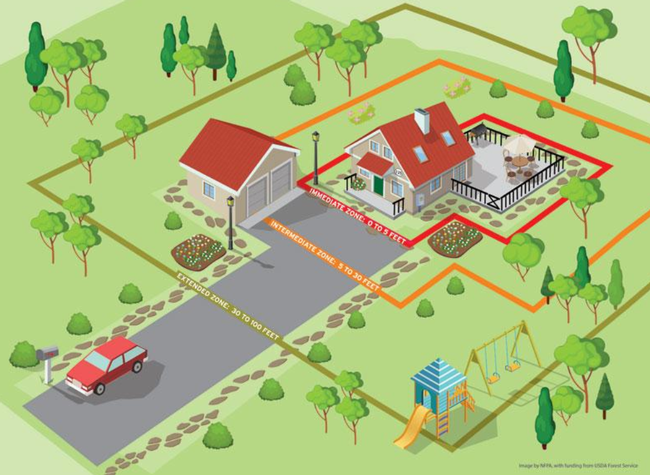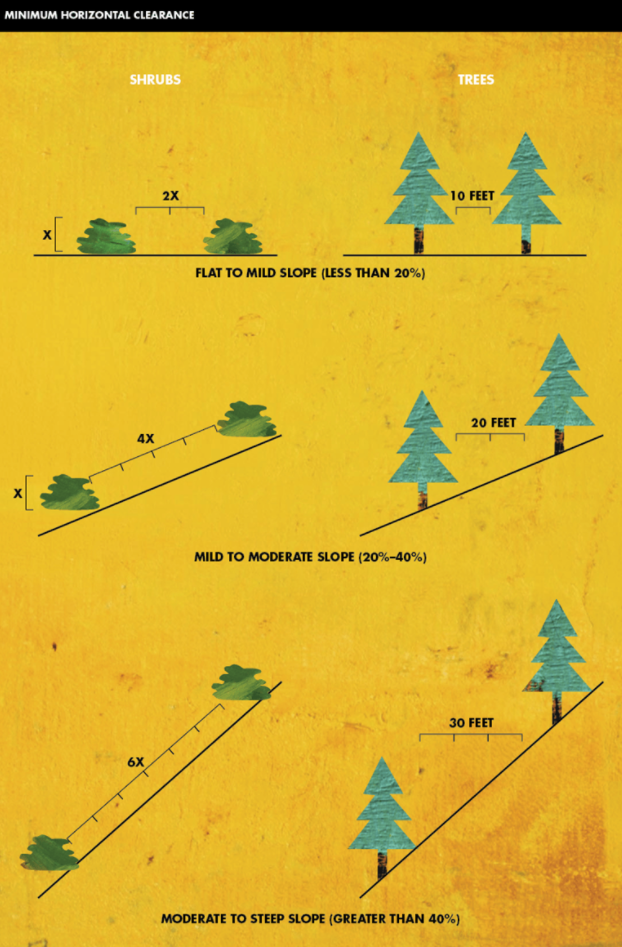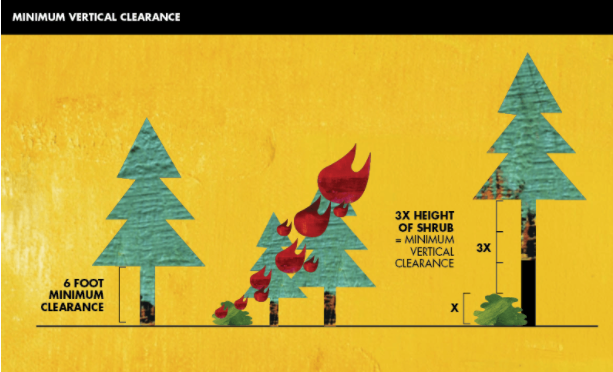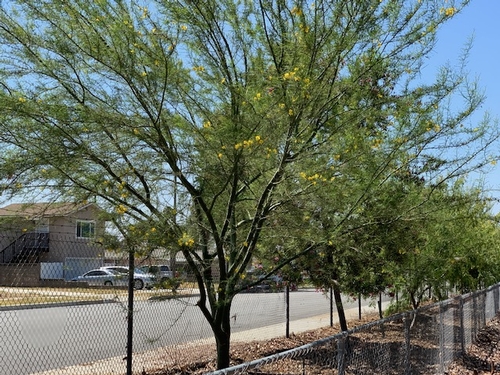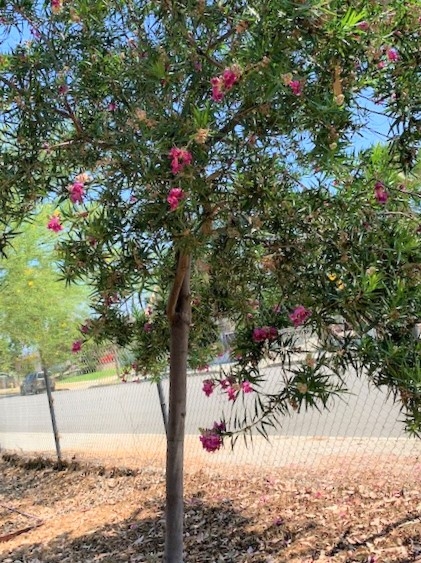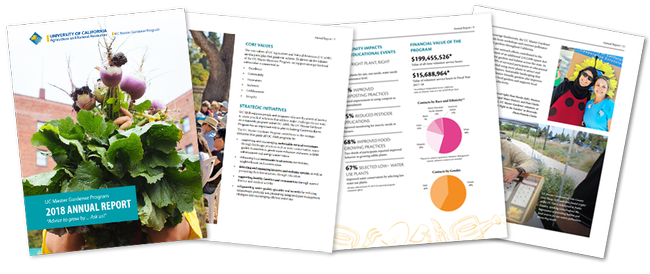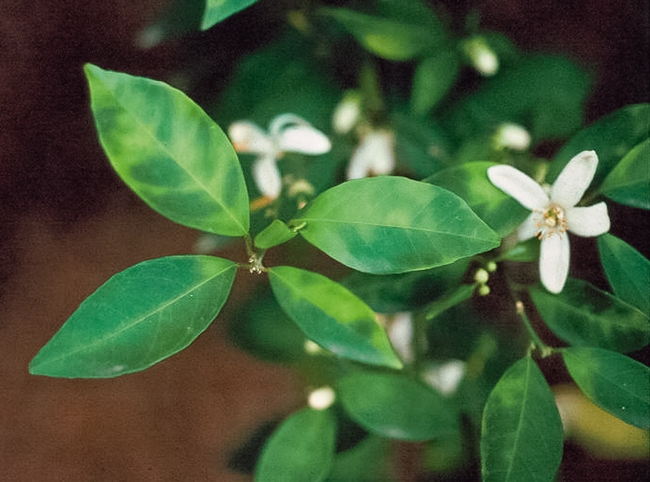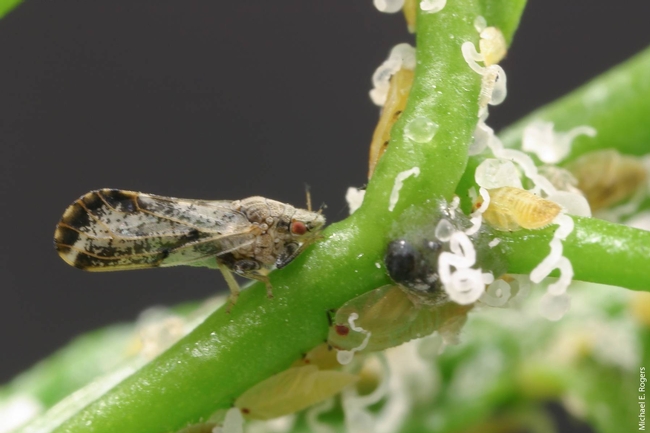Posts Tagged: master gardeners
Tips for Enhancing the Fire-Resistance of Your Home Landscape
Welcome to another “New Normal!” Due to climate change resulting in hotter, drier conditions and reduced snowpack, the occurrence of a “fire season” which traditionally occurred from May through October is becoming a misnomer, with fire occurring throughout the year. The severity of what may lie ahead over the next several months was highlighted in a recent tweet posted by CAL FIRE: “Compared to last year, California has seen over 2,650 more fires and a nearly 2000% increase in the acres burned year-to-date (January 1 – September 7), across all jurisdictions.”
Indeed, Fall often hosts strong offshore winds that can quickly spread destructive fires, exacerbated by the impacts of climate change. What can you do to help ensure ‘defensible space' that increases the safety of your family, pets and property in fire-prone areas? First and foremost, select and properly maintain fire-resistant plants augmented with hardscapes and fire breaks extending from your home to at least one hundred feet outward. (This also helps ensure access to your home by firefighters and other first-line responders in the event of a fire or other life-threatening event.)
Vegetation chosen for your defensible space should have low flammability and can include trees and shrubs along with herbaceous plants. Allowing adequate space between woody plants is important to avoid a continuous fuel path (fuel ladder) where fire starting at ground level can climb to the top of a tree and spread from tree to tree.
1. Follow these ‘defensible space' guidelines to reduce the risk of fire spread and damage:
Zone 0 (first 5 feet from structures): avoid anything combustible including woody plants, mulch, woodpiles, trellises, and stacked items. Instead, add walkways and mulch and other hardscaping made from pebbles and rocks, pavers, rock mulch, or pea gravel. Include a 6-inch noncombustible area extending from the ground to the exterior siding of structures.
Zone 1 (5-30 feet from structures): Eliminate fire spread by ensuring adequate space between trees, removing lower branches. Consider adding irrigated groundcovers or mowed grass or hardscapes between these plant groupings, as well. Properly maintain plants and remove dead portions of plants.
Zone 2 (31-100+ feet from structure to the property line): Concentrate on reducing the density of plants to slow the spread of fire and to reduce the height of flames. Woody plants should be spaced (as illustrated below) to prevent fuel ladders.
Defensible Zones (source: National Fire Protection Association, nfpa.org)
2. Remember that even a so called “fire-resistant” species that is under-watered or otherwise poorly cared for can be highly combustible. The conditions under which the plant is grown influences its fire-resistance more than the species itself. However, plant species high in wax, oil, and resins such as conifers tend to be highly flammable while manzanita and ceanothus (California lilac) are less so.
3. Avoid planting or spreading invasive species. While invasive plants are never recommended in any landscape, they are especially problematic in natural areas prone to wildfire. Once established they can fuel fire as well as crowd out native vegetation and associated habitat. Refer to the California Invasive Plant Council website for more information and specific examples and plants to avoid (www.cal-ipc.org).
4. Follow recommended planting and pruning guidelines to prevent both horizontal and vertical spread from tree to tree. Horizontal spacing is directly related to the slope of the land and the height of the vegetation.
Photo above (courtesy of CAL FIRE) is a diagram to help you determine minimum horizontal clearance for tree and shrub placement to reduce fire risk.
Photo above (courtesy of CAL FIRE) shows a 5' shrub near a tree. In this example, 15' of clearance (3 x 5') is needed between the top of the shrub and the lowest tree branch to prevent a fire ladder.
5. While fire-resistant natives and adapted non-natives greatly reduce your chance of losing your home and property to wildfire, all plants will burn under favorable conditions. Ensure that plants receive adequate irrigation.
6. Rather than applying organic mulch near your home, use non-flammable materials such as stone and pebbles. Granite pathways are also suggested since they provide a fuel break. Firewood and propane tanks should also be kept away from your home.
References:
CAL FIRE “Ready for Wildfire”: https://www.readyforwildfire.org/prepare-for-wildfire/get-ready/defensible-space/
Drill, S. et al. (2009), S.A.F.E Landscapes: Southern California Guidebook, UC Cooperative Extension: https://ucanr.edu/sites/SAFELandscapes/files/93415.pdf
UC ANR “Preparing Home Landscaping for Fire”: https://ucanr.edu/sites/fire/Prepare/Landscaping/
Applications of Organic Mulch Result in Enhanced Tree Growth and Water Savings
I hope all of you and your loved ones are staying well and healthy as the pandemic continues. Involving yourself in outdoor activities is not only a great way to escape 'cabin fever' and improve your physical health but it is also good for you psychologically, as well.
A silver lining for me over the past few months has been the opportunity to summarize results of some research studies including an update from a mulch trial that I'll report on virtually rather than live at the American Society for Horticultural Science conference (that was to be held in Orlando). I thought you might be interested in the results.
The objective of the research project was to measure the impacts of organic mulch treatments on the growth and health of four species of low maintenance, drought-tolerant landscape trees under deficit irrigation. Species selected were Parkinsonia x ‘Desert Museum' (it's thornless!); Chilopsis linearis ‘Bubba' (Desert Willow) (beautiful magenta flowers!), Pistacia ‘Red Push' (hybrid from P. atlantica and P. integerrima with brilliant orange fall foliage), and Prosopis glandulosa ‘Maverick' (thornless). Trees were planted in a randomized complete block experimental design in at the Chino Basin Water Conservation District (CBWCD) in Montclair in October, 2016. Half of the trees received 4” of organic mulch and half did not. Trees were transplanted from 15-gallon containers and irrigated with recycled water at 80 percent of reference evapotranspiration (ETo) the first 12 months.
Irrigation was reduced to 50% ETo in November, 2017 which was maintained until May 2020, when irrigation ceased. While the study continues through October 2020, there are some interesting early results. Organic mulch applications enhanced growth with no loss in quality in the Pistacia, Prosopis glandulosa, and Chilopsis linearis trees while growth was actually better in the Parkinsonia trees that did not receive mulch. This may be due to the fact that its trunk and branches actively photosynthesize as well as its leaves. Parkinsonia leaves also feature sunken guard cells, providing another form of drought avoidance. Furthermore, they develop deep root systems and may not need the added benefit of reduced soil evaporation in the top few inches of soil provided by the mulch. While all of the species selected have wonderful attributes, the Parkinsonia 'Desert Museum' has all the best traits of its palo verde heritage including having no thorns and a continues bloom throughout summer.
A huge thanks to our UCCE San Bernardino County Master Gardener team (led by Irene) who take data quarterly on the trees, recording trunk circumference at 6" and 3'. This is another great example of the breadth and depth of the contributions of our wonderful volunteers!
The four species of landscape trees in this study are part of a larger study at University of California, Riverside to determine the ability of 12 species of landscape trees to mitigate impacts of climate change. While I'll be long retired, growth and health data of all species will continue to be evaluated through at least 2035. The study at CBWCD provided the opportunity for a mulch/no mulch treatment for four of the most promising species which was space-limited at UCR.
Below are plot photos from October 2016 (right after planting), July 2020 (no irrigation for 3 months), a mature 'Desert Museum' tree in prolific bloom (photo credit to Dr. Bob Perry, Emeritus Professor, Cal Poly Pomona), and a mature Chilopsis linearis 'Bubba' from our UCR plot.
Save the date! We will be hosting a virtual UCR Field Day on September 3, 2020 featuring our drought-tolerant landscape plots at UC Riverside that was to be held live last May. More information is forthcoming but it will provide at least four hours of continuing education hours and a chance for you to ask questions of Dr's Amir Haghverdi, Don Merhaut and myself.
Have a wonderful August in your garden!
Janet
2018 Annual Report: Celebrating Our Impact
Join me in celebrating the very first annual report for the UC Master Gardener Program! The annual report shares remarkable work and positive impacts made by UC Master Gardener volunteers over the past year.
In 2018, UC Master Gardener volunteers:
- Encouraged people to get outside and connect with nature. 71% of attendees at UC Master Gardener events reported spending more time gardening or outdoors.
- Taught food gardening best practices in communities throughout California. Last year, 68% of our clientele reported improved practices in growing edible plants.
- Contributed to the establishment of pollinator gardens and habitat across the state. 70% of surveyed participants at educational events reported using more plants to attract and support pollinators.
While the UC Master Gardener Program annual report is focused on our collective accomplishments and all of the ways we connect with our mission throughout the year, the real story is centered on each and every one of our 6,154 volunteers. Our volunteers are the core of the UC Master Gardener Program and I am honored to thank you for your support and dedication.
2018 Annual Report link:
http://mg.ucanr.edu/files/302109.pdf
With gratitude,
Missy Gable
Director
UC Master Gardener Program
mjgable@ucanr.edu
(530) 750-1266
P.S. Data shared in the annual report comes directly from VMS and our collective statewide evaluation effort. If you are interested in your local county's impact data, please connect with your coordinator, individualized county data reports are shared quarterly.
Get Informed! Online continuing education available about the Asian Citrus Psyllid (ACP)
Continuing Education Opportunity
ACP can carry the disease huanglongbing (HLB), also known as citrus greening which currently has no cure and is fatal for citrus trees. UC Master Gardener volunteers are providing ongoing outreach and education of the public concerning ACP and HLB. This activity is crucial to saving our citrus and must be expanded throughout the state.
Improve your knowledge of citrus integrated pest management (IPM) and what you can do to help save our citrus through the various training materials, websites and an online course developed by UC Agriculture and Natural Resources experts.
Take the online course for continuing education today. This self-directed course familiarizes users with the biology and management of ACP and HLB. At the end of the course, a certificate is provided showing evidence of successful course completion. If asked for a password and login simply enter as a "guest" located under login at the bottom of the screen. This training is available to the public and no login is required.
Online training course: Asian Citrus Psyllid and the Dreaded Huanglongbing Citrus Disease
It is estimated that 60% of Californians have at least one citrus tree in their yard so HLB could have a devastating effect not only on California agriculture but also on the California residential landscape. Be part of the prevention effort by staying educated and alert to our local citrus. Save our citrus!
Sources:
California Department of Food and Agriculture: https://www.cdfa.ca.gov/plant/acp/
University of California ANR: http://ucanr.edu/sites/ACP/
University of California ANR Publication 8205: http://anrcatalog.ucanr.edu/pdf/8205.pdf
After 34 years of Service, Mary Lou Retires
Dear Master Gardeners,
I was hired to create Integrated Pest Management (IPM) programs for agriculture, but my interest in Master Gardeners started early. I remember attending the California State Fair in the early 1980's and being somewhat horrified to find the UC Master Gardeners answering questions using the Ortho Problem Solver and the Rodale Guide to Organic Gardening. I was told that they relied on these books because UC provided very little garden pest management information. This motivated me to write Pests of the Garden and Small Farm and later to hire Steve Dreistadt to compile Pests of Landscape Trees and Shrubs. From there we moved on to the Pest Notes, Quick Tips, UC IPM web site, UC IPM kiosk, our YouTube channel, blog and Twitter. Master Gardeners embraced and promoted all these products and now UCIPM is as well known for its home and garden information as for agricultural IPM.
I have loved teaching Master Gardener volunteers. They are the most enthusiastic students ever. I learn something every single time I go out and teach a class—and I've taught thousands of them. UC Master Gardeners inspire so much of what we do.
For example, it was Master Gardeners who stimulated our research on convergent lady
beetle releases for aphid control. All the published literature said releases weren't useful, but Master Gardeners challenged this idea. Over a 3-year study, Steve Dreistadt and I found that they were right, and we published several journal articles documenting the results.
Last but not least, thank you to all of you Master Gardener Coordinators. Each of you does an incredible job gently guiding and informing your enthusiastic volunteers. I have watched you in action and you do something special every day.
Sincerely,





